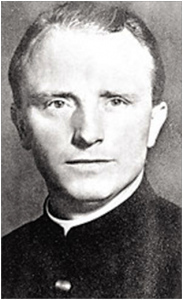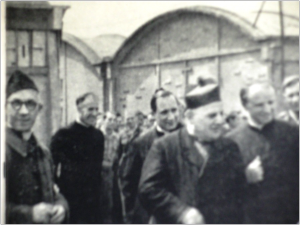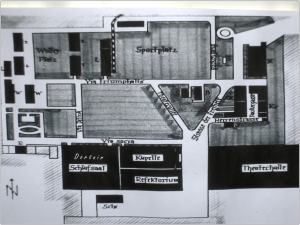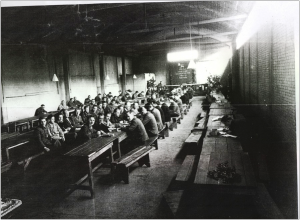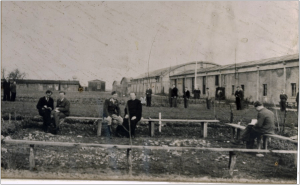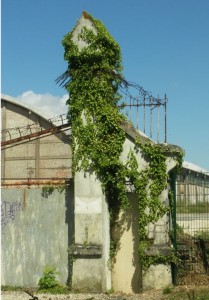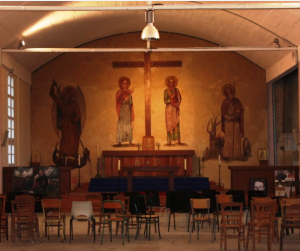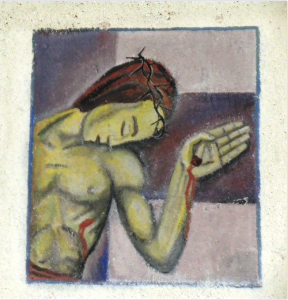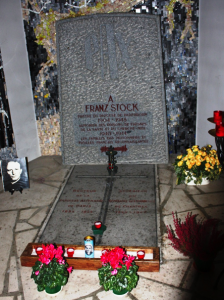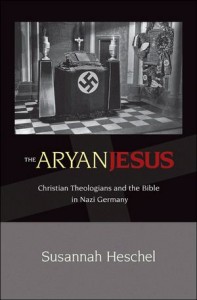Contemporary Church History Quarterly
Volume 21, Number 3 (September 2015)
Response to William Doino Jr. and the Film Lo vuole il Papa
By Susan Zuccotti, Independent Scholar
In the June 2015 edition of the Contemporary Church History Quarterly, William Doino Jr. discussed a documentary televised in Italy on April 1 entitled Lo vuole il Papa. Based on the work of historian Antonello Carvigiani, the film argued that Pope Pius XII was personally involved in the opening of convents and monasteries in Rome to thousands of Jews and other fugitives who were trying to escape arrest by the German occupiers of the Eternal City after September 1943. The film portrayed the oral testimonies of four nuns who, when they arrived as novices at four different religious houses in Rome years ago, were told by some of the older sisters about rescue efforts during the war. Accompanying each of the testimonies were brief filmed excerpts from the wartime chronicles of their institutions, recording a papal role in rescue. In addition, the documentary presented the oral testimonies of two men hidden as boys in two of the convents. Doino found the film persuasive, described it as new, and related it to other documents, accounts, and testimonies that he has discussed elsewhere and believes to be evidence of a clear papal directive for Jewish rescue in Rome.
When examined closely, the testimonies of the nuns and the chronicles are diverse in content and questionable as evidence. Let us begin with content. The first nun represented the cloistered Augustinian Sisters of the Santi Quattro Coronati, where 24 people, including at least 6 and perhaps as many as 17 Jews, were hidden. She explained that she was told that the pope had ordered the convent to open its doors to fugitives, including Jews. Relevant lines from that convent’s handwritten wartime chronicle, first made public in 2006 and thus not particularly new, confirmed her words, stating, “In this painful situation [of the German arrests and torture of fugitives beginning, the chronicler’s account, in November 1943] the Holy Father wants to save his children, including the Jews, and orders that hospitality in monasteries be given to the persecuted, and also the cloistered convents must adhere to the desire of the Supreme Pontiff [emphasis mine].”[1]
The film’s second witness was from the cloistered Cistercian Sisters of Santa Susanna, where roughly 18 military and political refugees and 26 Jews had been sheltered. This nun also referred to a papal directive for rescue, but added that the order had gone to all superiors of all Catholic institutions in Rome. How could she have known that? The accompanying lines from Santa Susanna’s handwritten war chronicle, made public in 2014, differed significantly from the nun’s testimony. The chronicler wrote, “In this situation the ecclesiastical authorities exhort and encourage and give their consent (with a maximum of caution) to opening the doors of the holy cloistered places to hide and receive as many persons as possible…[emphasis mine].”[2] Encouragement and consent from individual unknown prelates are important, but they are not the same as a papal order to all Church institutions. Words matter, and the implications differ. It is also important to note that Jews were not mentioned here, and caution was urged.
The third witness, from the convent of Santa Maria dei Sette Dolori which had sheltered 150 refugees including perhaps as many as 103 Jews, did not evoke a papal order.[3] Instead, she declared that she had been told that “The Holy Father wanted, desired, that the convent welcome these people.[emphasis mine]” Her testimony, in other words, resembled the written account from Santa Susanna. The accompanying handwritten chronicle from Santa Maria dei Sette Dolori confirmed her words, recording simply that the pope wanted institutions to take in fugitives, but “without obligation.” The fourth and final witness was from the Istituto Maria Santissima Bambina, which sheltered 123 people, including Jews. This nun was even more general, testifying simply that the sisters admitted fugitives because the pope appealed to them for charity. The accompanying typed chronicle also did not refer to a precise papal order, but it did provide insight on how rescue probably developed. It declared that at various times during the autumn of 1943 someone at the Vatican Secretariat of State requested the director of this particular institution to take in specific endangered individuals or families. The chronicle added that such a request could not be refused. But, significantly, it also declared that some 120 people, refugees or families made homeless by bombing raids, had already been accepted at the Istituto by the end of September 1943, well before the roundup of Jews in Rome on October 16 and the mass flight of surviving Jews into Catholic institutions.
We shall return to the issues of content raised in the film, but let us next examine the nature of the evidence. It is not easy to question the oral testimonies, filmed in the beautiful settings of their convents, of four elderly nuns, earnest, articulate, and confident of the accuracy of their information. But these women are providing hearsay, not first-hand, evidence. Their information apparently reached them at unspecified times for unknown reasons from unnamed associates, about whose personal histories we know nothing. The older sisters who passed along the information may have been young novices themselves during the war, with no special knowledge at that time about which fugitives were Jews or why they were there. Their own superiors may have told reluctant or fearful younger sisters that the pope wished or even ordered rescue measures to convince them to help fugitives, including atheists, Communists, and, especially, Jews, but the telling did not make it true. This evidence would not hold up in a court of law, and historians should apply similar criteria. Second, why were the young incoming nuns told such things privately in the 1950s, 60s, or 70s at all, at a time when no such accounts were being made publicly, despite the fact that Pius XII had long been criticized for not helping Jews? And why did the nuns wait until now to come forward? And why do they (and those who write about them, like Doino) stress help given to Jews, when it is clear from other records that at least half of those sheltered in religious institutions were political or military fugitives or non-Jewish civilian war refugees?
The written evidence presented in Lo vuole il Papa is equally problematic. The film provides a cursory glimpse of the volumes of war chronicles from the four convents, and then zooms in on the few lines relevant to the shelter of outsiders in each case. It gives no information about when, why, and by whom the rescue accounts were written or why they have not been made public sooner. With this technique it is impossible to detect what is obvious from a more careful study of the accounts—that they were not written during the war, and were often not even recorded by the chronicler who wrote the previous or subsequent entries. Examples abound. In the pages for 1943 and 1944 of the chronicle of the Santi Quattro Coronati, the author wrote in an entry for June 6, 1944, when Rome was liberated, that a general in the army of Mussolini’s Italian Social Republic wanted for war crimes after the conflict was sent to hide in the convent by the Vatican Secretariat of State (this attribution very specific) and stayed for five years. The war chronicle of the Santa Maria dei Sette Dolori referred to gas chambers, which would not have been understood with certainty in the first half of 1944, and to papal efforts to hide fugitives in the Pontificio Seminario Romano Maggiore (referred to as the Laterano) and Castel Gandolfo, equally secret at the time. The chronicles, then, are not wartime diaries but subsequent secondary accounts. Who wrote them, and when, and where did the information come from?
The testimony in Lo vuole il Papa of two fugitives hidden during the war is no more enlightening. Piero De Benedetti Bonaiuto found shelter at the convent of the Santi Quattro Coronati. In that convent’s war chronicle, which recorded the presence of five political fugitives or “patriots,” six Jews, and thirteen unspecified individuals, he was listed as a “patriot.” In his filmed testimony, he briefly discussed his experience in hiding and offered an opinion that special authorization would have been needed because the convent was subject to the rules of strict cloister. As a boy, he would have known nothing about a papal order. The second survivor-witness, Renato Astrologo, hid with his parents, grandmother, and three siblings in the convent of Santa Susanna. According to an article in the Vatican newspaper L’Osservatore Romano on June 3, 2014, the women entered the convent on October 24, 1943, while the men hid elsewhere until the end of January 1944. The article also stated that Astrologo was a convert from Judaism to Catholicism. In his testimony, Astrologo expressed his gratitude to the sisters who had saved him and stated his understanding that an order had “come from a high place.” He also could have known nothing more specific at the time.
Lo vuole il Papa might be more persuasive if it were confirmed by the other sources Doino mentioned in his article, but that is decidedly not the case. For example, Doino refers to an article in the Palestine Post on June 22, 1944, in which a correspondent wrote that “several thousand refugees, largely Jews” had been sheltered in the papal palace at Castel Gandolfo “during the recent terror.” This allegation has been repeated endlessly, but there is no evidence that the refugees were “largely Jews.” The pope did offer shelter and sustenance at Castel Gandolfo to hundreds, perhaps even thousands, of refugees escaping Allied bombing raids and German attacks on villages near Rome in the late winter and spring of 1944. Some of those refugees may have been Jews with false papers and not known to be Jewish. But no evidence has yet been unearthed to indicate that those involved in providing assistance believed that they were helping Jews. There is, furthermore, no personal testimony from Jews about receiving such shelter, although Jewish accounts of being hidden in other religious institutions in Rome are plentiful.[4]
Doino also alludes to statements about a papal directive from priest-rescuers Paolo Dezza, Pietro Palazzini, Hugh O’Flaherty and John Patrick Carroll-Abbing; the Jewish survivor Michael Tagliacozzo; and historians Andrea Riccardi, Anna Foa, Sister Grazia Loparco, Antonello Carvigiani, and Pier Luigi Guiducci. His list is not exhaustive; he could have mentioned other secondary sources. Each of these cases must be examined carefully, in more detail than is possible here. Looking briefly at the first four primary sources, however, the Jesuit Father Dezza, rector of the Pontifical Gregorian University during the war and later a cardinal, wrote on June 28, 1964, during the controversy concerning Rolf Hochhuth’s play The Deputy critical of Pius XII, that the pope had instructed him to accept persecuted civilians and Jews.[5] Strangely, Dezza never repeated the claim in his other writings, and it is not clear if refugees were in fact hidden in his institution.
Father Palazzini, also later a cardinal, published a book in 1995 describing his role in helping hide some 145 non-Jews and 55 Jews at the Pontificio Seminario Romano Maggiore. He made no reference to a papal order in his book, but he did refer to “the guidelines provided by Pope Pius XII…to save human lives.” He added that during the war, “to rediscover [the sense of reciprocal charity], one voice was often raised among the din of arms: it was the voice of Pius XII. The refuge offered to so many people would not have been possible with his moral support, which was much more than a tacit consent.”[6]As evidence of the guidelines and support, Palazzini referred to eight papal speeches. Three of the eight, at Christmas 1942 and on June 2, his name day, in 1943 and 1944, included brief references to the pope’s compassion for those persecuted because of nationality and race, but did not directly mention religion or Jews. The other five speeches simply stressed the need for charity to all victims of war.[7]
The Irish Father Hugh O’Flaherty took enormous risks to aid escaped Allied prisoners of war during the German occupation of Rome, but Jews are rarely mentioned among those he helped.[8] The story of the American Father John Patrick Carroll-Abbing, later a monsignor, is much the same. In addition to prisoners of war, Father Carroll-Abbing worked with political fugitives, partisans, civilian refugees, homeless children, and the poor in general. In 2000, he apparently informed Doino that the pope told him many times to help Jews, but his two books about his wartime activities, published in 1952 and 1966, rarely mentioned Jews at all. He never wrote that he took personal initiatives to help Jews, that the pope told him to hide Jews, or even that Jews were hidden in Vatican properties. His single written reference to papal involvement in Jewish rescue was an indirect observation rather than a personal experience. Without declaring that the statement affected his own work, he observed that after the roundup of Jews in Rome on October 16, 1943, “word came from the Vatican that, because of the emergency, nuns would be allowed to give hospitality in their convents to Jewish men as well as their families [emphasis mine].”[9] He added that the permission was given specifically to the Sisters of Nostra Signora di Sion, who passed it along to other convents.
There is little doubt that some 187 Jews were among those hidden by the Sisters of Nostra Signora di Sion. Many of the Jews fled there on October 16, 1943, as the Germans were rounding up their families and friends in the nearby former ghetto of Rome and throughout the city. The initial rescue effort was spontaneous. Since the convent was not cloistered and operated a girls’ boarding school that was virtually empty because of the war, there was no need for immediate papal authorization to receive outsiders. The sisters have never claimed to have received a papal directive for rescue, although they stress that they informed the head of their order and that the pope ultimately knew what they were doing.[10] The situation was similar at the Istituto Pio XI, a boarding school for some 200 to 250 boys run by the Salesians. In his study of more than 80 Jewish boys sheltered there during the war, Francesco Motto found no evidence of a papal order. He too emphasized that Vatican authorities had some idea of what was happening, and that the Salesian brothers immediately involved were convinced that they were acting according to the wishes of the Holy Father.[11]
In addition to many more accounts of Jewish rescue in Church institutions that do not mention a papal directive, there are some that specifically deny it. One example of the latter is Brother Maurizio, the steward at the Fatebenefratelli Hospital that hid some 46 Jews during the German occupation. Brother Maurizio related that after admitting Jewish fugitives on October 16, 1943, the directors duly notified Vatican officials. When they received no response, they took the silence for approval and increased their efforts.[12] Father Elio Venier, later a monsignor, recalled his work at the parish church of Santa Maria della Divina Provvidenza, where about 65 Jews were sheltered. He declared that officials at the Vicariate were informed of the rescue activities because parish churches were under their jurisdiction, but he added that the pope did not get involved in such matters.[13] The French Capuchin Father Marie-Benoît who, working with Jewish and non-Jewish friends and associates, placed and supported some 2,500 Jewish refugees in both religious and secular institutions in Rome, agreed.[14] After the war, but only when asked, he explained that he had received no money and no mission from the Vatican.[15]
Other reasons to doubt the existence of an order from Pius XII for rescue relate to known papal directives that seem contrary to it. Both Francesco Motto, writing about the Salesians, and the spokeswomen for the convent of Nostra Signora di Sion refer to a letter received on October 25, 1943, declaring, “The secretary of state of His Holiness expresses the confidence that [your] conduct…will be inspired by diligent observation of the dispositions and instructions provided by the Holy See and by that discreet and prudent correctness that is always, but now more than ever, necessary.”[16] Such a call was not conducive to extensive rescue. Two months later, on December 27, six days after Italian Fascist and German SS raids on three Vatican properties, Pius XII told the director of La Civiltà Cattolica that it was necessary to be more prudent with regard to refugees and added, “Yes, exercise charity with the many piteous cases that arise, but avoid the use of false documents and any even slight appearance of fraud.”[17] The pope may not have understood that it was almost impossible for fugitives, Jewish or not, to hide in any institutions without false documents.
Another German-Fascist raid on February 3-4, 1944, this time on the huge extraterritorial Basilica di San Paolo fuori le Mura, caused some at the Vatican to pull still further away from support for the rescue of fugitives. Little could be done for the 64 victims of the raid, including five Jews, but Vatican officials publicly and vehemently protested the violation of extraterritoriality to the Germans. Privately, however, they were terrified of additional and still more brutal raids, the arrests of more of their protégés, and the possibility of diplomatic incidents. On February 6, Vatican Secretary of State Cardinal Luigi Maglione wrote that he had “instructed the abbot [of the monastery at San Paolo], in the name of the Holy Father, not to permit disguises in other clothing: no one should wear religious habits if he is not a priest or monk.”[18] It is not clear how broadly this prohibition was distributed, but it was not an encouragement for rescue.
Far more serious, sometime that same February a message went out from the Vatican ordering that all non-clerics sheltered in a number of properties of the Holy See be asked to leave. Strict penalties for disobedience were specified. Again, all the recipients of this order are not known, but the message clearly went to the Seminario Lombardo, the Seminario Romano Maggiore, and the Collegio dei Sacerdoti per l’Emigrazione Italiana. Directors of the institutions reluctantly obeyed, although they never left their guests in the lurch. New hiding places were found, and in some cases the fugitives returned after a time.[19] Similar orders were issued within the Vatican City itself, where at least 50 outsiders were being sheltered in the private apartments of prelates living in the Canonica di San Pietro.[20] In this case, the prelates engaged in sheltering fugitives appealed, and the order was not enforced.[21]
There is no question that thousands of Jews were sheltered in church institutions in Rome during the German occupation. One survey conducted soon after the war placed the number at 4,447, in 220 female and 60 male religious houses.[22] Another more recent analysis refers to 4,169 Jews in 234 religious houses.[23] While numbers vary, the phenomenon of rescue is clear; what is unclear is how it happened. Historians and other scholars study the story not to glorify or vilify Pope Pius XII but to try to understand the events themselves. To do so, they look to the evidence, both written and oral. When the evidence is conflicting, they examine its validity—its authenticity; the motives of those who supply it; the timing; the possibility of error, bias, or misunderstanding. They also analyze the plausibility and consistency of the evidence within a wider context—in this case, with consideration of the pope’s other actions, statements, and concerns during the Second World War. Finally, they study the precise words used in testimonies. With this in mind, let us return to the documentary film Lo vuole il Papa, examine it in the context of other evidence mentioned here, and attempt to formulate an hypothesis about Jewish rescue in Rome.
Judging from the conflicting evidence in the film and from the other testimony discussed in this article, it seems unlikely that Pius XII ordered Catholic institutions in Rome to open their doors to Jews and other fugitives. It is possible that in some cases he was involved in granting permission to cloistered convents to suspend their rules regarding outsiders, but it is not probable that he ordered them to do so.[24] We have seen here indications of the pope’s hesitancy regarding rescue, his counter-instructions, and his requests for prudence, as well as the denials of a papal directive by some religious spokesmen and the failures to mention it by others. We know from the internal discussion concerning fugitives sheltered within the Vatican City that some prelates opposed their presence and tried to make them leave. Would they have taken that position if the pope had ordered all Catholic institutions in the city to accept them? And in the broader context, Pius XII was anxious to preserve Vatican neutrality and diplomatic privileges, and protect his institution and the Catholic faithful from German reprisals. Why would the pope jeopardize these priorities when a directive for rescue in Rome was not necessary? Romans who followed the pope’s public statements knew that he had urged charity and compassion for the victims of war on many occasions. They had read the articles in L’Osservatore Romano on October 25-26 and 29, 1943, following the roundup of 1,259 Jews in Rome, which referred to “the universally paternal charity of the Supreme Pontiff…which does not pause before boundaries of nationality, or religion, or race [emphasis mine]”—a clear reference to Jews that had not been used in previous papal speeches. They were aware that after Mussolini’s puppet regime ordered Italian police and carabinieri to arrest and intern all Jews in the country on November 30, 1943, two more articles in the Vatican daily newspaper had objected vigorously, though without mentioning German measures of deportation and destruction.[25] Catholics who wanted to hear all this could hear. In rescuing Jews and other fugitives, they firmly believed they were heeding the will of their pope.
But if there was no comprehensive papal order, how did rescue develop? In many cases, as for the Salesians and the Sisters of Nostra Signora di Sion, it was initially spontaneous—fugitives came to the school or convent and asked for help. Authorization came later. But to explain many other cases, it is useful to look again at two of the written testimonies presented in Lo vuole il Papa. The chronicler for Santa Susanna wrote, “In this situation the ecclesiastical authorities exhort and encourage and give their consent (with a maximum of caution) to opening the doors of the holy cloistered places to hide and receive as many persons as possible…[emphasis mine].” Similarly, the chronicler for the Istituto Maria Santissima Bambina recorded that on several occasions during the autumn of 1943, someone at the Vatican Secretariat of State requested the director of the institution to take in specific endangered individuals or families. These claims are credible. Many individual priests and even high-ranking prelates in Rome had their own personal protégés, perhaps an anti-Fascist activist or partisan, or the Jewish spouse of a friend or family member, or a former Jewish teacher or classmate, employer or employee, doctor or nurse—the possibilities are endless. Catholic institutions taking in outsiders needed recommendations about the backgrounds, personal integrity, and, sometimes, economic reliability of prospective guests. Priests and prelates, sometimes at a high level, supplied those recommendations and undoubtedly implied that rescue was the will of the pope. Although directors of religious houses were not unwilling in any case, such recommendations and reassurances were hard to refuse.
The pope did not oppose the opening of religious houses in Rome to fugitives unless he believed that the risks to rescuers and rescued alike were excessive. Although he certainly understood much of what was going on in his own diocese (the pope was the bishop of Rome), he probably did not know the details. He did not wish to become personally involved. And while he allowed some of his advisors to act on behalf of Jews and other fugitives, he was well aware that others close to him opposed rescue.
Does it matter whether there was a broad order for Jewish rescue from Pius XII or whether rescue was rather either spontaneous or the result of the private initiatives of individual priests and prelates? The answer is yes, for two reasons. First, understanding private individual initiatives helps us better comprehend the complexities and risks of the pope’s situation on an international level and the pressures he was under from within. We may learn more about these internal pressures when the Vatican archives of the papacy of Pius XII are opened. Until then, the study of Jewish rescue in Rome provides some clues. But above all, examination of the origins of rescue helps us to appreciate how and why it happened. As we consider the nuns described in Lo vuole il Papa, along with Cardinals Pietro Palazzini and Elio Venier, the Sisters of Nostra Signora di Sion, the Salesian brothers, Father Marie-Benoît, and so many others, we see the true nature of courage, generosity, and commitment to religious and human values. It is to be hoped that Pope Pius XII himself would be among the first to want that heroism recognized.
[1]For more on the chronicle of the Sisters of the Santi Quattro Coronati, see especially 30giorni, n. 7/8, August 2006, pp. 32-46. See also Antonello Carvigiani, “Aprite le porte, salvate i perseguitati,” Nuova Storia Contemporanea, September-October 2014, 131-44. The estimate of 17 Jews sheltered is from an often-cited list published in Renzo De Felice, The Jews in Fascist Italy, trans. Robert L. Miller, (1961 and 1993; New York: Enigma Books, 2001), 751-56, 752. De Felice indicated that the list came to him from the German Jesuit Father Robert Leiber, Pius XII’s close advisor and friend, who in turn stated that it was compiled after the war by another Jesuit priest and verified in 1954. For details on the list, see Susan Zuccotti, Under His Very Windows (New Haven: Yale University Press, 2000), 199-200.
[2]For more on Santa Susanna, see Carvigiani, “Aprite le porte,” 131-44. The number 26 is from De Felice, 752.
[3] The number 103 is from De Felice, 751.
[4] For details on what is known about refugees at Castel Gandolfo, see Susan Zuccotti, “Pius XII and the Rescue of Jews in Italy,” in Joshua d. Zimmerman, ed., Jews in Italy under Fascist and Nazi Rule, 1922-1945 (Cambridge: Cambridge University Press, 2005), 287-307, 306. It is noteworthy that Carvigiani, “Aprite le porte,” 132, cites as an authority, and with approval, statistics by Dominiek Oversteyns, De geschiedenis van de Hebreeërs in Rome tijdens de nazibezetting en vervolging in Rome (Rome: Privata, 2013), n.p., which declare that there were no Jews at Castel Gandolfo. I am not able to verify the Oversteyns citation.
[5] Dezza had been asked to contribute to a special edition of L’Osservatore della Domenica dedicated to the memory of Pius XII. His contribution is on pp. 68-69. Originally titled Der Stellvertreter, The Deputy opened in Berlin in 1963, in London as The Representative in the same year, and in New York in 1964.
[6]Pietro Palazzini, Il Clero e l’occupazione tedesca di Roma: Il ruolo del Seminario Romano Maggiore (Rome: Apes, 1995), 17 and 35.
[7] Palazzini did not mention articles in L’Osservatore Romano on October 25 and 29 and December 3 and 4, 1943, to be discussed below, which did refer to religion and Jews.
[8]See, for example, J.P. Gallagher, Scarlet Pimpernel of the Vatican (London: Souvenir, 1967).
[9]Carroll-Abbing, But for the Grace of God (London: Secker and Warburg, 1966), 55-56. The first book is A Chance to Live (New York: Longmans, Green, 1952). For Doino’s account of his conversation with Carroll-Abbing, see William Doino, “ The Pope Gave Me Direct Orders to Rescue Jews,” Inside the Vatican, August-September 2001, special insert, x. For details, see Susan Zuccotti, “Pius XII and the Rescue of Jews in Italy,” in Zimmerman, p. 298.
[10]The number 187 is from De Felice, 752. For details on rescue efforts at the convent of Nostra Signora di Sion, see Susan Zuccotti, Under His Very Windows, 189-93.
[11] De Felice, 754, puts the number of boys sheltered at 83. For details on the Salesian rescue effort, see Susan Zuccotti, Under His Very Windows, 191-92.
[12]The number 46 is from De Felice, 754. For Brother Maurizio’s testimony, see Federica Barozzi, “ ‘I percorsi della sopravvivenza,’ (8 settembre ’43-4 giugno ’44): Gli aiuti agli ebrei romani nella memoria di salvatori e salvati,” unpublished thesis, Università degli studi di Roma “La Sapienza,” 1995-96, 156.
[13]Monsignor Elio Venier, interview with this author, Rome, November 13, 1996. The number 65 is from De Felice, 755.
[14] For this estimate of refugees assisted, see Settimio Sorani, L’assistenza ai profughi ebrei in Italia (Rome: Carucci, 1983) , pp. 150-51; and Centro di documentazione ebraica contemporanea (CDEC), Milan, b. 8-A-I, f. Delasem—Settimio Sorani, “Attività della ‘Delasem’ dopo l’8 settembre 1943” by Sorani, May 16, 1944. The number given by De Felice, 755, for “Father Benedict of Bourg d’Iré” (Father Marie-Benoît, or, as he was known in Rome, Father Maria Benedetto) was too high.
[15] For details, see Susan Zuccotti, Père Marie-Benoît and Jewish Rescue (Bloomington, IN: University of Indiana Press, 2013), 179-80 and 223. Vatican documents published in Actes et Documents du Saint Siège relatifs à la seconde guerre mondiale (ADSS), eds. Pierre Blet, Robert A. Graham, Angelo Martini, and Burkhart Schneider (Vatican City: Libreria Editrice Vaticana, 1975), IX, docs. 433 and 487, reveal that at least one high-ranking Vatican official disapproved of Father Marie-Benoît’s dealings with the Jews and tried to get him to stop.
[16]This appeal accompanied a protective placard issued by General Rainer Stahel, German military commander of Rome, to many religious institutions throughout the city on October 25, 1943. The placard, to be posted outside each institution, read, “This building serves religious objectives, and is a dependency of the Vatican City. All searches and requisitions are prohibited.” As we shall see, this placard did not always prevent raids. For details, see Susan Zuccotti, Under His Very Windows, 193.
[17]Giovanni Sale, “Roma 1943: occupazione nazista e deportazione degli ebrei romani,” La Civiltà Cattolica, IV, quaderno 3683, December 6, 2004, 417-29, 426, from a document in the archives of La Civiltà Cattolica. The pontifical institutions raided were the Seminario Lombardo, the Collegio Russo, and the Istituto Orientale.
[18]ADSS, XI, doc. 30, notes of Maglione, 126.
[19] Reference to this order may be found in the archives of the Seminario Lombardo, b.7.A.73, Diario, “Appendice,” 17-18. For details, see Susan Zuccotti, Under His Very Windows, 225-28.
[20] The number 50 is from ADSS, X, doc. 53, Monsignor Guido Anchini, head of the Canonica, to Pius XII, February 13, 1944, 127-29. Nearly all the guests were men. Roughly 24 of the 50 were non-Jews, another 17 were described as non-Aryan Catholics, and 7 were described as Jews with no mention of religion. There is no record of any guests being hidden elsewhere in Vatican City.
[21] Ibid.
[22] De Felice, 751-56.
[23] Dominiek Oversteyns, De geschiedenis van de Hebreeërs in Rome tijdens de nazibezetting en vervolging in Rome (Rome: Privata, 2013), n.p, cited in Carvigiani, “Aprite le porte,” 132
[24]Rules of cloister are far more complex than is usually stated. Depending on the congregation, the rules often could be temporarily lifted by the head of the order. Also, some cloistered convents operated public spaces like guest houses, where the same strict rules did not apply. Some such convents may have employed Catholic laypersons to work in their public spaces.
[25]The articles in October were on page 1. The later articles, “Carità civile,” and “Motivazione,” appeared on December 3 and 4, both on page 1.

